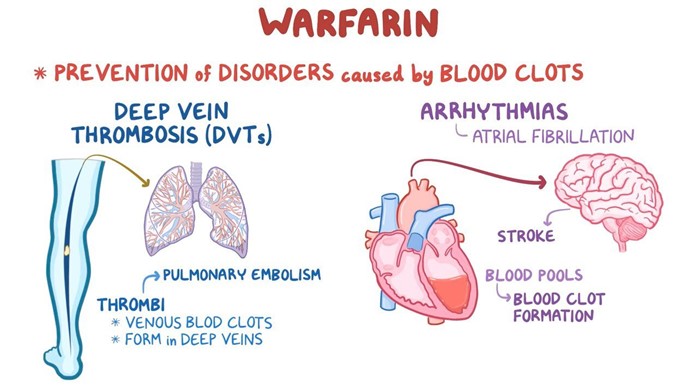A client is being discharged with a prescription for warfarin. Which instruction should the nurse provide this client regarding diet?
Increase the intake of dark green leafy vegetables while taking warfarin.
Eat two servings of dark green leafy vegetables daily and continue for 30 days after warfarin therapy is completed.
Eat approximately the same amount of leafy green vegetables daily so the amount of vitamin K consumed is consistent.
Avoid eating any foods that contain any vitamin K because it is an antagonist of warfarin.
The Correct Answer is C
Choice A reason: Increasing the intake of dark green leafy vegetables while taking warfarin is not a good instruction because it can decrease the effectiveness of warfarin. Dark green leafy vegetables are rich in vitamin K, which is a coagulation factor that counteracts the anticoagulant effect of warfarin.
Choice B reason: Eating two servings of dark green leafy vegetables daily and continuing for 30 days after warfarin therapy is completed is not a good instruction because it can cause bleeding complications. Dark green leafy vegetables are rich in vitamin K, which is a coagulation factor that counteracts the anticoagulant effect of warfarin. Stopping warfarin while continuing to eat high amounts of vitamin K can increase the risk of clot formation and thromboembolism.
Choice D reason: Avoiding eating any foods that contain any vitamin K because it is an antagonist of warfarin is not a good instruction because it can cause bleeding complications. Dark green leafy vegetables are rich in vitamin K, which is a coagulation factor that counteracts the anticoagulant effect of warfarin. Eliminating vitamin K from the diet can increase the sensitivity to warfarin and cause excessive bleeding and bruising.

Nursing Test Bank
Naxlex Comprehensive Predictor Exams
Related Questions
Correct Answer is A
Explanation
Choice A reason: This is correct because it addresses both the physical and emotional needs of the child and the mother. The nurse should provide comfort and reassurance to the mother and explain that occasional accidents are normal and not a sign of failure.
Choice B reason: This is incorrect because it implies that the mother is incompetent and needs external help. The nurse should first establish rapport and trust with the mother before suggesting any resources or interventions.
Choice C reason: This is incorrect because it suggests that there is something wrong with the child's kidneys, which may alarm and offend the mother. The nurse should not jump to conclusions without assessing the child's history and symptoms.
Choice D reason: This is incorrect because it generalizes and stereotypes boys as being slower than girls in toilet training. The nurse should not make assumptions based on gender and should respect individual differences.
Correct Answer is A
Explanation
Choice A: Observing insertion site is an essential assessment for a client who has a suprapubic catheter. The insertion site is located in the lower abdomen, where urine drains from an opening in the bladder through a catheter into a drainage bag. The nurse should inspect the site for signs of infection, inflammation, bleeding, or leakage. The nurse should also clean the site with soap and water and apply a sterile dressing as needed.
Choice B: Palpating flank area is not a relevant assessment for a client who has a suprapubic catheter. The flank area is located on the sides of the back, where the kidneys are located. Palpating the flank area can detect tenderness or pain that may indicate kidney infection or stones, but it does not provide information about the suprapubic catheter or its function.
Choice C: Measuring abdominal girth is not a relevant assessment for a client who has a suprapubic catheter. The abdominal girth is the circumference of the abdomen at the level of the umbilicus. Measuring abdominal girth can detect changes in fluid balance, ascites, or bowel obstruction, but it does not provide information about the suprapubic catheter or its function.
Choice D: Assessing perineal area is not a relevant assessment for a client who has a suprapubic catheter. The perineal area is located between the anus and the genitals. Assessing perineal area can detect signs of infection, irritation, or injury in the genital or anal regions, but it does not provide information about the suprapubic catheter or its function.
Whether you are a student looking to ace your exams or a practicing nurse seeking to enhance your expertise , our nursing education contents will empower you with the confidence and competence to make a difference in the lives of patients and become a respected leader in the healthcare field.
Visit Naxlex, invest in your future and unlock endless possibilities with our unparalleled nursing education contents today
Report Wrong Answer on the Current Question
Do you disagree with the answer? If yes, what is your expected answer? Explain.
Kindly be descriptive with the issue you are facing.
